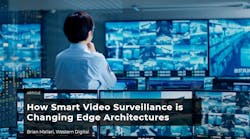The IoT revolution is transforming physical security for the connected age
The Internet of Things (IoT) has become deeply woven into the fabric of our daily lives. From smart speakers that dim our lights to thermostats that learn our preferences, connected devices have transformed how we interact with our environments. This digital revolution hasn't just changed our homes; it's reshaping expectations for physical security across every industry sector.
Today's IoT ecosystem extends far beyond simple connectivity. These intelligent devices create an interconnected web of sensors, cameras, and automated systems that seamlessly enhance our lives. As these technologies become more sophisticated and accessible in the consumer space, they drive new demands in professional security applications. The challenge for security professionals lies in meeting these elevated expectations while maintaining the robust security and reliability that enterprise applications demand.
From Smart Homes to Smart Security
The proliferation of residential IoT devices has fundamentally altered how people expect to interact with technology. Smart speakers respond to voice commands, while mobile apps control everything from door locks to security cameras. Smart plugs monitor energy usage, video doorbells enable remote visitor communication, and connected refrigerators help manage grocery inventory. This everyday experience with seamless, intuitive technology has raised the bar for what users expect from their professional security systems.
The transition makes sense. If someone can check their home security cameras from their smartphone while on vacation, why shouldn't they have similar capabilities at the office? Shouldn't professional security be just as responsive if voice commands can control home automation systems? These consumer experiences are reshaping expectations for enterprise security solutions, pushing the industry toward more integrated, user-friendly approaches.
And this shift isn't just about convenience. Today's IoT devices offer unprecedented levels of integration and intelligence.
- Smart sensors can detect everything from environmental changes to unusual movement patterns. These sophisticated devices can monitor air quality, detect smoke or gas leaks, identify sudden temperature fluctuations, and even recognize specific sounds like breaking glass or calls for help. Advanced motion sensors can also differentiate between normal foot traffic and suspicious behavior like loitering or pacing.
- Video analytics can identify specific behaviors or situations requiring attention. Using AI-powered algorithms, these systems can detect when someone falls, recognize aggressive actions, spot abandoned objects, or identify when people enter restricted areas. They can also analyze crowd patterns and movement flows, helping security teams proactively respond to potential incidents before they escalate.
- Access control systems can integrate with mobile credentials and biometric authentication. This allows organizations to move beyond traditional key cards, enabling employees to use their smartphones as secure credentials while incorporating additional verification methods like fingerprint scanning or facial recognition. The systems can also provide detailed audit trails and allow administrators to modify access privileges across entire facilities instantly.
The Security Industry's IoT Evolution
While the security industry has embraced IoT technology more cautiously than the residential sector, the adoption rate continues to accelerate. This measured approach reflects the industry's necessary focus on reliability and cybersecurity. However, as these technologies become more robust and secure, their integration into security systems has expanded dramatically.
Modern security installations now commonly feature diverse IoT devices tailored to specific locations and needs throughout a facility. Video security cameras work alongside audio sensors to detect unusual sounds or calls for help. Environmental sensors monitor air quality and detect smoke. Access control systems integrate with mobile credentials and biometric readers. Motion sensors and other detection devices create a comprehensive security mesh that provides real-time awareness of facility status.
These integrated solutions are transforming operations across sectors. In retail environments, IoT devices optimize store operations while enhancing security and monitoring everything from customer flow patterns to inventory levels.
- Educational settings use smart sensors to create safer learning environments by detecting potential threats and monitoring environmental conditions. The systems can simultaneously identify unauthorized entry through multiple access points, monitor noise levels to detect disturbances in typically quiet zones, track visitor movements throughout campus, and integrate with mass notification systems for coordinated emergency communications.
- Healthcare facilities leverage IoT technology for patient safety and critical area monitoring, with immediate alerts when assistance is needed. Smart sensors can detect wandering patients in memory care units, monitor medication storage temperatures, identify unauthorized access to restricted pharmaceutical areas, and adjust lighting and environmental controls based on patient care schedules and staff routines.
- Smart/Safe cities take this integration even further, creating comprehensive public safety networks that respond rapidly to emerging situations. These systems can detect water main breaks through pressure monitoring, identify potential crowd control issues at major events, automatically dim street lighting to aid emergency response visibility and coordinate multiple agencies' resources through unified command interfaces.
The power of these systems lies in their ability to work together seamlessly through sensor fusion and orchestration. When an incident occurs, multiple IoT devices provide different pieces of the puzzle – video security systems capture visual data, audio sensors detect unusual sounds, and environmental sensors monitor changing conditions. This multi-layered approach enables security personnel to understand and respond to situations more effectively.
The Connected Future of Security
As IoT technology matures, we're seeing accelerated security system adoption. The integration capabilities have become more sophisticated, while the devices have grown more powerful and secure. This evolution has made it possible to create truly comprehensive security solutions that can adapt and respond to changing conditions in real time.
The future promises even deeper integration and enhanced capabilities. Voice interaction with security systems, already emerging in some applications, will likely become more common as users seek the same convenient interface they enjoy at home.
- Edge computing capabilities are expanding rapidly, allowing for more sophisticated processing at the device level. This means faster response times and more intelligent automated actions. Smart sensors can now detect subtle changes in behavior patterns or environmental conditions, triggering appropriate responses before situations escalate. The combination of AI-powered analytics and IoT sensors enables predictive security measures that can help prevent incidents before they occur.
- Mobile devices will be increasingly central, serving as access credentials and control interfaces for security systems. The growing adoption of 5G networks will enable faster, more reliable communication between devices, opening up new possibilities for real-time monitoring and response.
- Advanced artificial intelligence and machine learning algorithms will continue to enhance the capabilities of IoT devices, enabling more sophisticated threat detection and automated response protocols. These technologies will help security systems become more proactive, identifying potential security risks before they materialize into actual threats. Integrating blockchain technology may also be crucial in securing IoT device communications and ensuring data integrity across security networks.
The true power of IoT in security lies not just in deploying smart devices, but in creating intelligent systems that work together seamlessly. As these technologies evolve, they'll enable capabilities we're only beginning to imagine. For security professionals, understanding and embracing this transformation will be crucial to meeting the evolving needs of tomorrow's security landscape. The future of security isn't about adding more devices – it's about making existing technologies work smarter to create more effective, efficient and responsive security solutions.
About the Author

Howard Carder
freelance writer specializing in the physical security and professional audio/video industries
Howard Carder is a seasoned freelance writer specializing in the physical security and professional audio/video industries. With over 30 years of experience, including a long tenure at a large, global video security company, Howard has crafted compelling content for leading brands and publications across the industry. His expertise spans video security and Pro AV technologies, allowing him to distill complex topics into engaging narratives. Howard's work includes hundreds of case studies, white papers, and thought leadership articles. When not writing, he enjoys playing music and exploring healthy cooking. Learn more at www.hcwriter.com.


